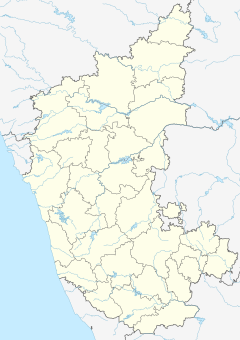โหยสเฬศวรเทวสถาน
| โหยสเฬศวรเทวสถาน | |
|---|---|
ಹೊಯ್ಸಳೇಶ್ವರ ದೇವಸ್ಥಾನ | |
 โหยสเฬศวรเทวสถาน | |
| ศาสนา | |
| ศาสนา | ศาสนาฮินดู |
| เขต | หัสสาน |
| เทพ | พระศิวะ |
| ที่ตั้ง | |
| ที่ตั้ง | หเลพีฑู |
| รัฐ | รัฐกรณาฏกะ |
| ประเทศ | ประเทศอินเดีย |
| พิกัดภูมิศาสตร์ | 13°12′47.5″N 75°59′42.0″E / 13.213194°N 75.995000°E |
| สถาปัตยกรรม | |
| ประเภท | โหยสฬะ |
| ผู้สร้าง | เกตมัฬฬะ, โหยสฬวิษณุวรรธนะ |
| เสร็จสมบูรณ์ | ศตวรรษที่ 12 |
โหยสเฬศวรเทวสถาน (กันนาดา: ಹೊಯ್ಸಳೇಶ್ವರ ದೇವಸ್ಥಾನ; Hoysaleswara temple) เป็นโบสถ์พราหมณ์สร้างขึ้นในศตวรรษที่ 12 บูชาพระศิวะ ตั้งอยู่ในหเลพีฑู รัฐกรณาฏกะ ประเทศอินเดีย ในสมัยที่เป็นราชธานีแห่งจักรวรรดิโหยสฬะ เทวสถานนี้สร้างขึ้นริมฝั่งทะเลสาบที่มนุษย์สร้างขึ้น โดยกษัตริย์วิษณุวรรธนะแห่งโหยสฬะเป็นผู้ดำริให้สร้างเทวสถานนี้ขึ้น[1] เริ่มต้นก่อสร้างราวปี 1121 แล้วเสร็จในปี 1160[2][3] ในต้นศตวรรษที่ 14 หเลพีฑูถูกโจมตีและทำลายสองครั้งโดยกองทัพมุสลิมของรัฐสุลต่านเดลีจากทางเหนือ[4][5][6] ทั้งเทวสถานและราชธานีจึงถูกทิ้งร้างในสภาพทรุดโทรมนับจากนั้น[7]
โหยสเฬศวรเทวสถานเป็นปูชนียสถานตามธรรมเนียมของลัทธิไศวะในศาสนาฮินดู แต่ก็มีสัญลักษณ์ของลัทธิไวษณวะ, ลัทธิศักติ ไปจนถึงเทวบุคคลของศาสนาไชนะปรากฏอยู่ด้วย[8] โหยสเฬศวรเทวสถานสร้างขึ้นเป็นเทวสถานคู่ บูชาศิวลึงค์โหยสเฬศวร และสันตเฬศวร ซึ่งแทนรูปปางบุรุษและสตรี ซึ่งเท่ากันและเชื่อมต่อกันที่ส่วนมุขยื่น (transept) ภายนอกมีสองประติมากรรมรูปโคนนทิ แต่ละรูปหันหน้าเช้าหาศิวลึงค์ทั้งสองภายใน[9] ภายในเทวสถานยังมีศาลขนาดย่อมที่ประดิษฐานพระสูรยะ ในอดีต เทวสถานมีโครงสร้างเป็นหอคอยสูงชะลูด แต่พังทลายหรือถูกทำลายลงมานานแล้ว ปัจจุบันหลังคาของเทวสถานมีลักษณะเรียบ[10] เทวสถานหันหน้าออกทางตะวันออก กระนั้นในปัจจุบันทางเข้าอยู่ทางเหนือ ทั้งเทวสถานหลักและศาลโคนนทิล้วนสร้างขึ้นจากแบบแผนสี่เหลียมจัตุรัส (square plan)[11] เทวสถานนี้สร้างขึ้นโดยแกะสลักจากหินสบู่ และเป็นที่รู้จักจากงานประติมากรรมและงานแกะสลักนูนต่ำที่วิจิตร และจากทั้งประตอมานวิทยา ประวัติศาสตร์ และจารึกทั้งภาษาของอินเดียเหนือและใต้ งานศิลปกรรมของเทวสถานนี้แสดงให้เห็นวิถีชีวิตของผู้คนในศตวรรษที่ 12 ปัจจุบัน งานแกะสลักนูนต่ำขนาดใหญ่รวม 340 ภาพเป็นภาพที่เกี่ยวกับเทววิทยาและปรัมปราวิทยาของศาสนาฮินดู[8] งานแกะสลักภาพเล็กกว่าพบแสดงเรื่องราวจากคัมภีร์ฮินดู เช่น รามายณะ มหาภารตะ และ ภาควตปุราณะ[1][12][9]
งานศิลปกรรมของโหยสเฬศวรเทวสถานเสียหายแต่ส่วนใหญ่แล้วยังคงสภาพอยู่ โดยรอบของเทวสถานยังเต็มไปด้วยซากปรักหักพังสถาปัตยกรรมโหยสฬะ เช่น ไชนพสาทิเทวสถาน และ เกทาเรศวรเทวสถาน[1][13]
อ้างอิง
[แก้]- ↑ 1.0 1.1 1.2 Permanent Delegation of India to UNESCO (2014), Sacred Ensembles of the Hoysala, UNESCO
- ↑ Kirsti Evans 1997, p. 8.
- ↑ Foekema (1996), p.59
- ↑ Robert Bradnock; Roma Bradnock (2000). India Handbook. McGraw-Hill. p. 959. ISBN 978-0-658-01151-1.
- ↑ Catherine B. Asher (1995). India 2001: Reference Encyclopedia. South Asia. pp. 29–30. ISBN 978-0-945921-42-4.
- ↑ Joan-Pau Rubiés (2002). Travel and Ethnology in the Renaissance: South India Through European Eyes, 1250-1625. Cambridge University Press. pp. 13–15. ISBN 978-0-521-52613-5.
- ↑ Kamath (2001), p129
- ↑ 8.0 8.1 Kirsti Evans 1997, pp. 196–199.
- ↑ 9.0 9.1 Krishna 1971, pp. 33–34, 37–46.
- ↑ Krishna 1971, pp. 34–36.
- ↑ Gerard Foekema 1996, pp. 59–61.
- ↑ Kirsti Evans 1997, pp. 8–10, 196–199.
- ↑ Krishna 1971, pp. 33–35.
บรรณานุกรม
[แก้]- Prasanna Kumar Acharya (2010). An encyclopaedia of Hindu architecture. Oxford University Press (Republished by Motilal Banarsidass). ISBN 978-81-7536-534-6.
- Prasanna Kumar Acharya (1997). A Dictionary of Hindu Architecture: Treating of Sanskrit Architectural Terms with Illustrative Quotations. Oxford University Press (Reprinted in 1997 by Motilal Banarsidass). ISBN 978-81-7536-113-3.
- Vinayak Bharne; Krupali Krusche (2014). Rediscovering the Hindu Temple: The Sacred Architecture and Urbanism of India. Cambridge Scholars Publishing. ISBN 978-1-4438-6734-4.
- Alice Boner (1990). Principles of Composition in Hindu Sculpture: Cave Temple Period. Motilal Banarsidass. ISBN 978-81-208-0705-1.
- Brown, Percy (1949). Indian Architecture. Indian Architecture. D.B. Taraporevala.
- Alice Boner; Sadāśiva Rath Śarmā (2005). Silpa Prakasa. Brill Academic (Reprinted by Motilal Banarsidass). ISBN 978-8120820524.
- A.K. Coomaraswamy; Michael W. Meister (1995). Essays in Architectural Theory. Indira Gandhi National Centre for the Arts. ISBN 978-0-19-563805-9.
- Dehejia, V. (1997). Indian Art. Phaidon: London. ISBN 0-7148-3496-3.
- Dewan, Janet (1989). "The Hoysalesvara temple of Halebid in early photography". History of Photography. 13 (4). doi:10.1080/03087298.1989.10441009.
- Adam Hardy (1995). Indian Temple Architecture: Form and Transformation. Abhinav Publications. ISBN 978-81-7017-312-0.
- Adam Hardy (2007). The Temple Architecture of India. Wiley. ISBN 978-0470028278.
- Adam Hardy (2015). Theory and Practice of Temple Architecture in Medieval India: Bhoja's Samarāṅgaṇasūtradhāra and the Bhojpur Line Drawings. Indira Gandhi National Centre for the Arts. ISBN 978-93-81406-41-0.
- Harle, J.C., The Art and Architecture of the Indian Subcontinent, 2nd edn. 1994, Yale University Press Pelican History of Art, ISBN 0300062176
- Monica Juneja (2001). Architecture in Medieval India: Forms, Contexts, Histories. Orient Blackswan. ISBN 978-8178242286.
- Stella Kramrisch (1976). The Hindu Temple Volume 1. Motilal Banarsidass (Reprinted 1946 Princeton University Press). ISBN 978-81-208-0223-0.
- Stella Kramrisch (1979). The Hindu Temple Volume 2. Motilal Banarsidass (Reprinted 1946 Princeton University Press). ISBN 978-81-208-0224-7.
- Michael W. Meister; Madhusudan Dhaky (1986). Encyclopaedia of Indian temple architecture. American Institute of Indian Studies. ISBN 978-0-8122-7992-4.
- George Michell (1988). The Hindu Temple: An Introduction to Its Meaning and Forms. University of Chicago Press. ISBN 978-0-226-53230-1.
- George Michell (2000). Hindu Art and Architecture. Thames & Hudson. ISBN 978-0-500-20337-8.
- Kamath, U. Suryanath: A Concise History of Karnataka from pre-historic times to the present, Jupiter books, 2001, MCC, Bangalore (Reprinted 2002), OCLC 7796041.
- Sastri, Nilakanta K.A.: A History of South India, (1955), From Prehistoric times to fall of Vijayanagar, OUP, New Delhi (Reprinted 2002), ISBN 0-19-560686-8.
- Gerard Foekema (1996). A Complete Guide to Hoysaḷa Temples. Abhinav Publications. ISBN 978-81-7017-345-8.
- Kirsti Evans (1997). Epic Narratives in the Hoysaḷa Temples: The Rāmāyaṇa, Mahābhārata, and Bhāgavata Purāṇa in Haḷebīd, Belūr, and Amṛtapura. BRILL. ISBN 90-04-10575-1.
- Hardy, Adam (1995). Indian Temple Architecture: Form and Transformation-The Karnata Dravida Tradition 7th to 13th Centuries. Abhinav Publications. ISBN 81-7017-312-4.
- Krishna, M.H. (1971). Halebid: Hoysalesvara Temple. Mysore Archaeological Department, University of Mysore (Orig-year: 1930).
- Narasimhacharya, Ramanujapuram (1990). Halebid temple (pages 6-10) of Mysore Archaeological Report, vol. 1911. Asiatic Society (Orig year 1911).
- T. A. Gopinatha Rao (1993). Elements of Hindu iconography. Motilal Banarsidass. ISBN 978-81-208-0878-2.
- Ajay J. Sinha (2000). Imagining Architects: Creativity in the Religious Monuments of India. University of Delaware Press. ISBN 978-0-87413-684-5.
- Burton Stein (1978). South Indian Temples. Vikas. ISBN 978-0706904499.
- Katherine Kasdorf (2013). Forming Dōrasamudra: Temples of the Hoysaḷa Capital in Context. Columbia University Press.
- Burton Stein (1989). The New Cambridge History of India: Vijayanagara. Cambridge University Press. ISBN 978-0-521-26693-2.
- Burton Stein; David Arnold (2010). A History of India. John Wiley & Sons. ISBN 978-1-4443-2351-1.
- Kapila Vatsyayan (1997). The Square and the Circle of the Indian Arts. Abhinav Publications. ISBN 978-81-7017-362-5.



